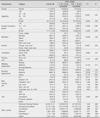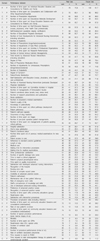Abstract
Purpose
The purpose of this study was to explore the use of outcome indicators and perception of outcome evaluation of oncology advanced practice nurses (APNs).
Method
A total of 111 oncology APNs from hospitals which have over 400 beds were surveyed. The participants' use of outcome indicators and perception of outcome evaluation were collected using a questionnaire including 84 outcome indicators for APNs developed by Sung et al. and 13 items on APNs' contribution to the hospitals developed by Kleinpell (2005). Data were analyzed using descriptive statistics, t-test, and χ2 test.
Result
Twelve items out of 84 outcome indicators were used over 50% of the time and 57 items could be used in the future by the participants. Seven of the 10 top-ranking outcome indicators in use were education related and were also expected to be used frequently in the future. The score for participants' perception of outcome evaluation was average-high, 3.82 out of 5.
Figures and Tables
Table 3
High Ranked Performance Indicators on Past Use and Differences according to APN's Career (N=111)

Table 4
High Ranked Performance Indicators on Future Use and Difference according to APN's Career (N=111)

This table is shown statistics on yes only and no respondents were excluded.
APN=advanced practice nurse;
C=Clinical indicator; F=Financial indicator; S=Satisfaction indicator; T=Time saving indicator; P=Process; O=Outcome
*Added indicator among performance indicators of experienced use
†Fisher's exact test
References
1. Byers JF, Brunell ML. Demonstrating the value of the advanced practice nurse: an evaluation model. AACN Clin Issues. 1998. 9:296–305.

2. Burns SM. Kleinpell R, editor. Selecting advanced practice nurse outcome measures. Outcome assessment in advanced practise nursing. 2009. 2nd eds. New York: Springer Publishing Co;89–105.
4. Cho MS, Cho YA, Kwon IG, Seo MJ, Back HJ. Importance, satisfaction and contribution of advanced practice nurses' role recognized by health care professionals. J Korean Acad Nurs Adm. 2011. 17:168–179.

5. Cunningham RS. Advanced practice nursing outcome: a review of selected empirical literature. Oncol Nurs Forum. 2004. 31:219–232.

6. Hong JH. The role of oncology advanced practice nurses in Korea. 2004. Seoul: Seoul National University;Unpublished master's thesis.
7. Jastremski CA. Using outcomes research to validate the advanced practice nursing role administratively. Crit Care Nurs Clin North Am. 2002. 14:275–280.

8. Kang IW, Koh MS, Kim TS, Min S, Park JS, Oyum YH, et al. An introduction to Nursing. 2008. Seoul: SooMoonSa.
9. Kim KS, Kang JY, Kim BJ, Yi YH, Lee EN. A delphi survey on performance indicators of Korean advanced practice nurses. J Korean Clin Nurs Res. 2010. 16:131–143.
10. Kim MY, Park SA. A methodology research of performance appraisal tool of oncology advanced practice nurse. J Korean Acad Nurs Adm. 2007. 13:17–23.
11. Kim SR, Lee SK, Kim SH, Kwan YH, Bae SH, Lee SS, et al. The satisfaction of patients and medical team about CNS roles performance. Clin Nurs Res. 2003. 9:76–90.
12. Kim SS, Kwak WH, Moon SM, Sung YH. Development of a role model for physician assistant in Korea. Clin Nurs Res. 2006. 12(1):67–80.
13. Kleinpell RM. Acute care nurse practitioner practice: results of a 5-year longitudinal study. Am J Crit Care. 2005. 14:211–219.

14. Kleinpell RM. Kleinpell R, editor. Measuring outcomes in advanced practice nursing. Outcome assessment in advanced practice nursing. 2009. 2nd eds. New York: Springer Publishing Co;1–62.
15. Kleinpell RM, Ely EW, Grabenkort R. Nurse practitioners and physician assistants in the intensive care unit: An evidence-based review. Crit Care Med. 2008. 36:2888–2897.

16. Kleinpell R, Gawlinski A. Assessing outcomes in advanced practice nursing practice: The use of quality indicators and evidence based practice. AACN Clinical Issues. 2005. 16:43–57.
17. Kwon YD, Kwon IG, Sung YH, Hwang MS. A study on the present status of Clinical Nurses with Expanded Role. J Korean Clin Nurs Res. 2008. 14:99–115.
18. Kwon IG, Kim YH, Hwang KJ, Kim HS, Lee BS, Lee HS, et al. A survey on the role and present state of advanced practice nurses in Korea. Clin Nurs Res. 2003. 9:55–75.
19. Ingersoll GL, McIntosh E, Williams M. Nurse-sensitive outcomes of advanced practice. J Adv Nurs. 2000. 32:1272–1281.

20. Lee ER, Kwak MK, Kim EJ, Kwon IG, Hwang MS. Job analysis of Korean oncology advanced practice nurses in clinical workplace: using the DACUM method. J Korean Oncol Nurs. 2010. 10:68–79.
21. Lynch MP, Cope DG, Murphy-Ende K. Advanced practice issues: results of the ONS advanced practice nursing survey. Oncol Nurs Forum. 2001. 28:1521–1530.
22. Ministry of Health and Welfare. 2008 Reports of statistics on cancer enrollment. 2010. 12. 29. June 28, 2010. Retrieved from http://ncc.re.kr/manage/manage03_033_view.jsp?bbsnum=169&hSelSearch=&hTxtKeyword=¤t_page=1&cd=null.
23. Ministry of Health and Welfare. The rule on certification of advanced practice nurse. 2012. 03. 19. June 28, 2010. Retrieved from http://www.law.go.kr/LSW/lsLinkProc.do?&lsNm=%EC%A0%84%EB%AC%B8%EA%B0%84%ED%98%B8%EC%82%AC%EC%9E%90%EA%B2%A9%EC%9D%B8%EC%A0%95%EB%93%B1%EC%97%90%EA%B4%80%ED%95%9C%EA%B7%9C%EC%B9%99&joLnkStr=&chrClsCd=010202&mode=20#0000.
24. Shin YG. An administration of human respect: Approach of organizational behavior. 1997. Seoul: DaSan Books.
25. Sidani S, Irvine D. A conceptual framework for evaluating the nurse practitioner role in acute care settings. J Adv Nurs. 1999. 30:58–66.

26. Song MS, Kim KN, Noh WJ, Um OB, Han YH. 2011 Annual Report. 2011. Seoul: Hospital Nurses Association.
27. Sung YH, Lim NY, Park KO, Jung JH, Kwon IG, Kim US, et al. Job analysis for role identification of clinical nurses with expanded role. J Korean Clin Nurs Res. 2009. 15:139–155.
28. Sung YH, Yi YH, Lim KC, Jeong JS, Cho MS, Kim KO, et al. The development of outcome indicators for advanced practice nurses. J Korean Clin Nurs Res. 2010. 16:157–174.




 PDF
PDF ePub
ePub Citation
Citation Print
Print





 XML Download
XML Download